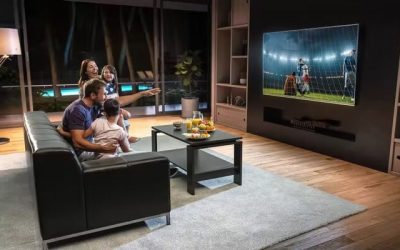Christmas is coming! Families are getting together and the light shows are starting! However, it’s probably been close to a year since you’ve considered how to tackle the tangled Christmas lights!
If you’re not sure where to start, don’t panic! Simply read our complete guide to outdoor Christmas lighting to help you stay safe & happy when it comes to decorating your home. Apply the following 9 tips to light up your home and make it stand out – the merry kind of way!
Tip 1: Safety first – always

Our sparkies would be millionaires if they got a dollar for every time they heard the word ‘safety’ at Sarros Electrical! Unsurprisingly, we figured this is a great place to start when it comes to hanging out your Christmas decorations and lights.
Before plugging anything in, or even before hanging things up for that matter, we suggest taking stock and visually checking any decorative lights you already have.
Most people figure they need to buy new fairy lights, but most boxes come with spare bulbs that can replace any broken ones, saving you from buying more. Additionally, by first examining the wires connecting the bulbs, you can see if any have frayed or cracked. Some people feel that simply duct-taping over any cracks is sufficient, but we strongly recommend retiring any decorative lights with frayed wires to err on the side of safety. Frayed or exposed wires are an unacceptable shock and fire hazard.
After all, do you really want to risk your family’s safety, especially during the holiday period for the sake of saving a few dollars?
If you’re not sure if your lights are in good working order, you can test them using a hand-held tool known as a multimeter. A lot of households have one lying around somewhere, and if not they can be purchased from your local hardware store.
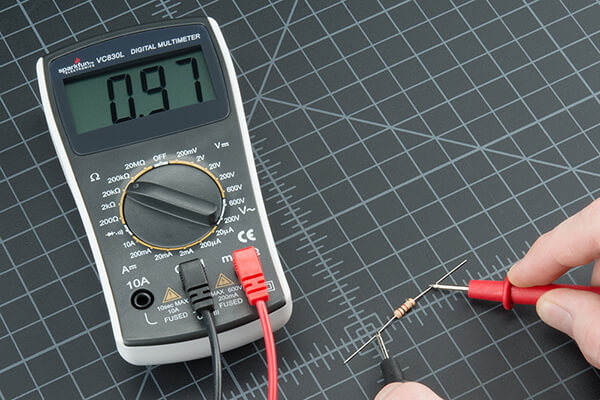
Tip 2: Use power point timers
Depending on where they’re placed, some lights can generate significant heat, especially when left on all night. Leaving Christmas lights on 24 hours a day also adds up when it comes to electricity consumption.
One way to avoid the heat issue is to switch light bulbs from inefficient incandescent bulbs (which convert only 10% of electricity to light). We suggest using LEDs instead. Not only can they be up to 90% more efficient in terms of energy-to-light conversion, they actually last longer too.
So how do you reduce the power bill without sacrificing your Christmas decorations?
Use power point timers! Power point timers turn off the power to your Christmas lights at a certain time, turning them back on again later. This can help you save electricity late at night when everyone’s in a slumber as well as during the day when decorative lights generally aren’t effective.

Some power point timers even have two timers in one – so you can turn your decorative lights off during the day and during the wee hours of the morning!
Tip 3: Spread the electrical load
We shouldn’t overload power points! Just because it’s possible to daisy chain or plug powerboards into powerboards doesn’t mean it’s safe.
The more appliances plugged into one socket, the more electricity needs to flow through that point, and as a result, more heat is generated. As we mentioned before, we need to minimise heat as heat increases the risk of fire.
Granted, most outdoor decorative lights and fairy lights have a low voltage but it pays to be aware of this, especially if those power points are shared with other appliances.

First check the state of your power points, perhaps they need a clean – especially your outdoor power points. Ensure that they’re still looking fresh, in good condition and provide adequate protection from the weather.
And when it does come to plugging all your outdoor Christmas decorations in, spread your lights out instead of stuffing them all into one outlet. Be especially careful to not create stacks of power boards and connections outside in the weather – that’s a recipe for disaster! Be sure to know how to use power boards properly.
The general rule of thumb is to not load a power point by more than 80% of its maximum load, which may sound excessive but becomes very possible when shared with other appliances. If the box your Christmas lights come in hasn’t crumbled from old age (it’s ok; we’ve all been there) look at the watts or volts to find the amperage used by the light set.
As we’ll discuss later in this article there’s a difference between electrical items for indoor use and outdoor use, and power points are no exception. Sarros is currently the best installer for weatherproof outdoor GPOs or power points in WA’s Southwest and Perth – simply call us if you want to safely beef up your outdoor Christmas light display!
Tip 4: Use temporary hooks to hang lights
When it comes to hanging any form of string lighting from your house there’s a right way, and there’s most definitely a wrong way. There’s generally no need to drill and risk damage to bricks and concrete or cause undue gutter rust.
A simple and easy way (as of when this article was written) will cost you $5.99 at Bunnings. What is it I hear you ask? Gutter Hooks!

They simply hook over the top of your gutter and provide a small hooking surface for you to thread your lights over – and the best part… when the time comes to take down your Christmas lights, you can simply pop them back in the box and use them next year without any permanent damage to your wall, gutters and garden.
Tip 5: Electricity and water don’t mix!
Although this could arguably be in the safety section of this article considering how many people are injured due to electrical-related mistakes, it bears repeating as we want everyone to be safe during the Christmas period.
Not all lights are created equally, some are designed to work outdoors in the wet weather while others MUST be used and stored inside.
Some electrical devices, such as your computer, your phone, and sometimes even your Christmas lights have an IP rating. This 2-digit number tells you how resistant your object is first to dust (the first digit), and secondly to water (the second digit).
Indoor fairy lights straight up won’t have this rating as they’re purely designed for indoor use. However, if you do see a rating, it’s signifies that the device has been tested for outdoor use and will remain safe and functional even in wet conditions.
This rating, however does not extend to plugs and extension cords. This is because the ends of these are always exposed.
But, several devices can help. Known as “plug protectors” or “extension cord safety covers,” these simple devices act as a cover that fits around the connection of 2 cables and prevents moisture and dust from getting in.

This might sound excessive to some, but when it comes to your loved ones, can you ever be too safe? We strongly recommend always using plug protectors for outdoor applications.
Tip 6: Keep walkways clear
It’s also worth mentioning that all pathways should be kept clear of obstructions, including electrical cables, to avoid creating a trip hazard. This is especially important to homes occupied by those with potential balance issues such as young children and the elderly.
A great decorative idea is to ‘frame’ pathways by lining them with lights (as opposed to crossing them with lights). Not only does this look great, but it highlights the path people should take. It also makes things safer as you can see where you’re walking!

Additionally, we suggest not putting lights directly on grass or pathways as this can cause damage to bulbs or wires which in turn could lead to possible hazards. lights directly on the ground can be stomped on and are more exposed to moisture and dirt.
But wait…? How do we frame the footpath without placing lights on the path?
Use light stakes or holding pegs to elevate lighting off the ground. Take a quick trip to your local hardware store to get these stakes or similar items that will allow you to elevate your fairy lights just off the ground.
Framing pathways simply looks elegant – and it also maintains your family’s safety!
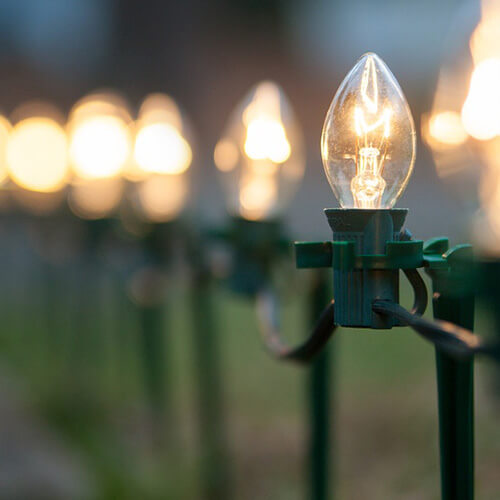
Tip 7: Remember ladder safety
Often using ladders and hanging Christmas lights come hand in hand. So keep these pointers in mind when installing your decorative lights.
Because you’re dealing with electricity, a metal ladder is a definite no-no. Metal ladders conduct electricity so any electrical current touching the ladder can easily cause electric shocks. Using a wooden, fiberglass or plastic ladder is preferable to any metal ladder.
Hang decorative lights fully unplugged FIRST, then connect them to the mains SECOND. We suggest visually checking the lights, then testing before hanging them. After testing, unplug them again before placing them where you want.
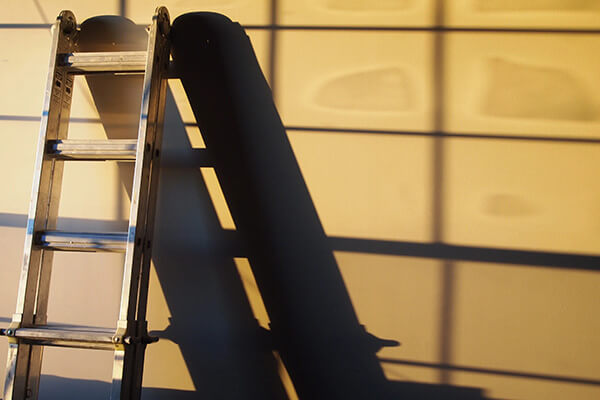
Also keep these standard ladder safety principles in mind:
- Choose the right ladder – one that isn’t metal and can take the weight.
- Check for damage before use.
- Set up on a flat stable surface.
- Never lean away from the ladder.
- Always maintain 3 points of contact.
- Ascend and descend slowly and safely.
- Don’t go beyond the recommended rung (use a suitable platform if you need more working space up there).
There’s no rush when it comes to hanging lights – you won’t be late for the light show just because you took a few extra minutes to work safely so do it right and do it safely!
Tip 8: Buy Christmas lights that meet Australian standards
All lights sold in Australia must meet strict Australian compliance standards. However, a side effect of globalization and easy access to the internet means many people wanting to save a dollar might purchase some foreign-sourced lighting.
Although this might make sense from a hip pocket point of view, it’s not a good move from a safety perspective. If something does go wrong with non compliant decorative lighting and damage is caused to your property, your insurance may not cover you.
Overseas products that don’t need to meet Australian production standards, longevity standards, and safety standards means you’re opening yourself up to an increased chance of danger. It might be a small chance, but why take one to save just a few dollars?

Tip 9: Store Christmas lights properly and safely
It’s already the end of February, the holiday season is clearly over and it’s about time to put those lights away – what’s the plan?
A large factor contributing to broken bulbs and frayed wires comes down to the method of storage, unfortunately, lights rarely come in anything more than a tacky cardboard box, so you’ll need to get imaginative.
Anything that’s cylindrical acts as an excellent object to wrap fairy lights around, for example, a spool or even an old gift-wrapping paper cylinder. Wrap slowly in a circular motion, maintaining tension and being careful not to crush any bulbs on the way around.
Remember the bulbs are small and fragile, so storing them correctly this year is saving money and preparing well for next year!
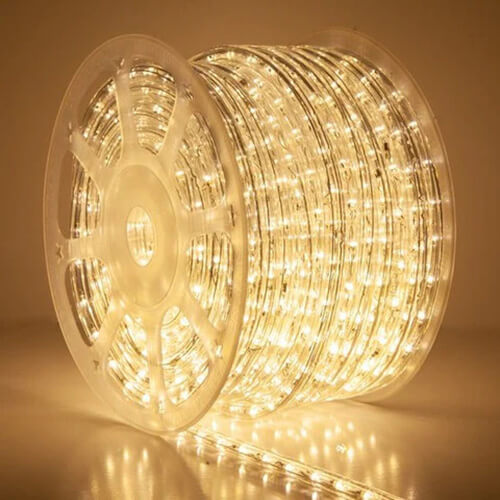
Last Tip: Enjoy the holidays!
Everyone deserves a break, and better yet everyone deserves a holiday. But most importantly, everyone deserves to be safe! We hope these tips help you to have a dazzling house that stands out from the crowd!
Enjoy the holidays and always stay safe. Sarros Electrical is here to help Western Australians keep their home safe when it comes to electricity – not just during Christmas, but all year round.


